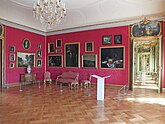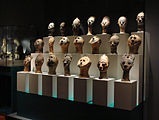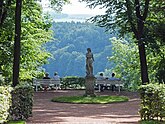Lichtenwalde Castle
Castle Lichtenwalde is in the same district of the municipality Niederwiesa in mittelsachsen befindliches baroque palace owned by the Free State of Saxony . The castle is surrounded by a baroque park with numerous water features , which in 2005 was named one of the most beautiful parks in Germany. The Castle Lichtenwalde with its park is one of three houses, in addition to Augustusburg Castle and Scharfenstein Castle belongs to the group "The Three worthwhile attraction".
history
Castle

Around 1230 a castle was built on the left bank of the Zschopau , 60 m above the valley. The builders are the Margraves of Meißen , who colonized the entire area south and west of the river from Rochlitz a few years earlier . The castle initially served as a bulwark against the imperial directors Mildenstein and Schellenberg , which bordered to the north and east, and was administered by a margrave castellan , in which capacity a knight Heidenreich von Lichtenwalde acted in 1280 .
After the castle was administered by the empire for a short time at the end of the 13th century, it fell back to the margraves in 1307, who pledged the property with all accessories in 1336 to the burgraves of Meißen and later lent it to them. The burgraves, for their part, gave the castle to the von Honsberg family a few years later, who ruled here until 1439, while the lordship of the castle fell back to the margraves in 1426. In 1439 Apel Vitzthum the Younger to Roßla and Konrad von Stein exchanged their possessions with those of Honsberg and thus became the new owners of the castle and lordship, but lost them again in the course of the Saxon fratricidal war in 1447.
From 1447 to 1561, the new owners were the von Harras , an old noble family from Thuringia. Initially, Hermann von Harras was enfeoffed with Lichtenwalde in 1447. The most important representative of the family was Dietrich von Harras († 1499), who took over the castle from around 1474 after the death of his mother Ilse together with three brothers. This Dietrich von Harras is the one from the Harrassage , to which Theodor Körner set a lasting memorial in his ballad Harras the bold springer .
After Dietrich's death, the rule first went to his son Georg II von Harras and then to Eustachius von Harras , who had the old castle converted into a residential palace in 1550 and died in 1561 without a male heir, whereupon the rule of Lichtenwalde fell to the Kurhaus Sachsen and in a sovereign office was transformed.
In 1694 the von Bünau family acquired Lichtenwalde in exchange for Pillnitz near Dresden, which Elector Johann Georg IV wanted to give to his mistress Magdalena Sibylla von Neitschütz .
lock
In 1719 Jakob Heinrich Graf von Flemming bought the indebted property of the von Bünau at auction and in 1722 sold it on to Christoph Heinrich Graf von Watzdorf . He had the remains of the old castle and Harrasschen Castle demolished and a large baroque castle built in its place. His son Friedrich Carl Graf von Watzdorf († 1764) had an extensive park laid out around the complex from 1730.
When Watzdorf died without descendants, Lichtenwalde came into the possession of his widow, Henriette Sophia, née Countess Vitzthum von Eckstädt, in 1764. With that, the property came back to Vitzthume after more than 300 years. The Counts Vitzthum von Eckstädt remained lords of the castle in Lichtenwalde until they were expropriated in 1945.
The building suffered severe damage as a result of a major fire that destroyed the roof and upper storey on Walpurgis Night in 1905. By 1908, the lord of the palace, Friedrich Graf Vitzthum von Eckstädt , had it rebuilt largely true to the original, but with eclectic changes, by the Dresden court architect Gustav Frölich .
In July 1945, the Red Army confiscated the castle and expelled the last lady of the castle, Countess Sibylle Vitzthum von Eckstädt († 1951), who had taken in several refugee families, out of the house. While the old lady found a new place to stay with friends in the village of Lichtenwalde until her death, the castle was plundered. After the military left in 1946, the furniture and the porcelain and painting collection of the Vitzthum family were no longer available.
For a long time, heirs from the Vitzthum family have been arguing with major German museums about the return of paintings from the family that hung in the castle and disappeared in their depots after the war (source: "Die Zeit", No. 26, June 2018).
The now nationalized castle was first used as a sanatorium from 1948, then as a TB sanatorium. In 1972 an educational institution of the GDR state health system was set up in the house. In 1990 the castle became the property of the re-established Free State of Saxony, which used the property as an educational center for the Saxon State Ministry for Social Affairs until 1995 . When the school moved to the newly built education center in Niederbobritzsch , the castle was initially empty.
Since 1999 the property management of the State Office for Finance has been managing the castle, which was given a new - museum - use. The castle, which is owned by the Free State of Saxony, has been extensively renovated in recent years. On March 28, 2010, after extensive renovation work, a completely new museum complex was opened. Previous exhibitions, such as the watch museum, have moved to Chemnitz. The majority of the paintings and furniture we see today come from a gift from the Chemnitz art dealer Georg Brühl (1931–2009).
Manorial rule
The jurisdiction , which existed until 1855, included not only the place Lichtenwalde but also the places Ebersdorf (now part of Chemnitz ), Nieder- and Oberlichtenau (now part of Lichtenau ), Nieder- and Oberwiesa (now part of Niederwiesa), Ortelsdorf (now part of Frankenberg ), Merzdorf , Ottendorf , Garnsdorf (semi-pro rata to 1823, then completely) Auerswalde (until 1832 semi pro rata basis, then all) Braunsdorf and Gückelsberg (today Floeha).
Castle complex
lock
The three-wing palace building, which is crowned on its main wing by a large tower-like roof turret, houses the former representative rooms of the count family in its south wing with the library, the red salon, the Chinese salon, the dining salon and the winter garden, in which the original festive furnishings are still partially preserved is.
The Chinese Salon used to be used to exhibit the Vitzthum porcelain collection and is now considered the most beautiful room in the house. Its interior dates from before the fire. The extensive restoration of the room began in autumn 2006.
The environmental library of the Saxon State Foundation for Nature and Environment is also located in Lichtenwalde Castle.
To the east is the castle courtyard, the renovation of which was completed in 2004. The adjoining castle chapel, which largely dates back to the 15th century, was extensively restored and re-consecrated in 2008.
Museum areas
The Lichtenwalde Castle Museum houses exhibition areas on the history of the house, the art of paper cutting and the art and culture of West Africa, East Asia and the Himalayan region. The representative rooms, furnished with paintings, historical furniture and Asian porcelain, bring a piece of the past of the historic house to life. In the north wing of the castle there has been a gallery for design since 2010, which is maintained by the Schneeberg Applied Arts Faculty of the West Saxon University of Applied Sciences in Zwickau.
Castle Park
The baroque garden was created between 1730 and 1737 on behalf of the landlord Friedrich Carl von Watzdorf. The 10 hectare park overgrown after the expropriation of the last castle owner in 1945. In 1954, work began on a restoration. In the years 1990 to 1997 the park was renovated in its original form. The last work on the park was completed in 2004.
The landscape architecture of the park includes water features, of which the “Seven Arts” is the best known.
The park can be entered daily, except on Mondays, during opening hours for an entrance fee.
Current
From May 14 to May 22, 2016, 150 original photos by Günter Rössler from the areas of reportage - fashion - nudes were on view in the exhibition "The genius of the moment" .
From October 20, 2016 to March 12, 2017 the exhibition "seven" with current theses from the Faculty of Applied Arts Schneeberg was presented in the AKS gallery.
literature
- The middle Zschopau area (= values of our homeland . Volume 28). 1st edition. Akademie Verlag, Berlin 1977, pp. 31–35.
- ASL Schlossbetriebe gGmbH (ed.): Lichtenwalde Castle and Park. Lichtenwalde 2011, ISBN 978-3-939609-76-6
- Ekkehard Kühnrich: The inhabitants in the village and castle Lichtenwalde (Saxony) 1550-1710. Plaidt: Cardamina 2014, ISBN 978-3-86424-208-3
- Richard Steche : Lichtenwalde. In: Descriptive representation of the older architectural and art monuments of the Kingdom of Saxony. 6th booklet: Amtshauptmannschaft Flöha . CC Meinhold, Dresden 1886, pp. 71-77.
- Jochen Voigt: room by room. Treasury of Lichtenwalde Castle. A guide through the exhibitions. Chemnitz 2010, ISBN 978-3-9808878-9-2
Web links
Individual evidence
- ↑ The three worth seeing
- ↑ Theodor Körner: Harras, the bold jumper (text)
- ^ Exhibition Günter Rössler
Coordinates: 50 ° 53 ′ 1.1 ″ N , 13 ° 0 ′ 38.9 ″ E





















